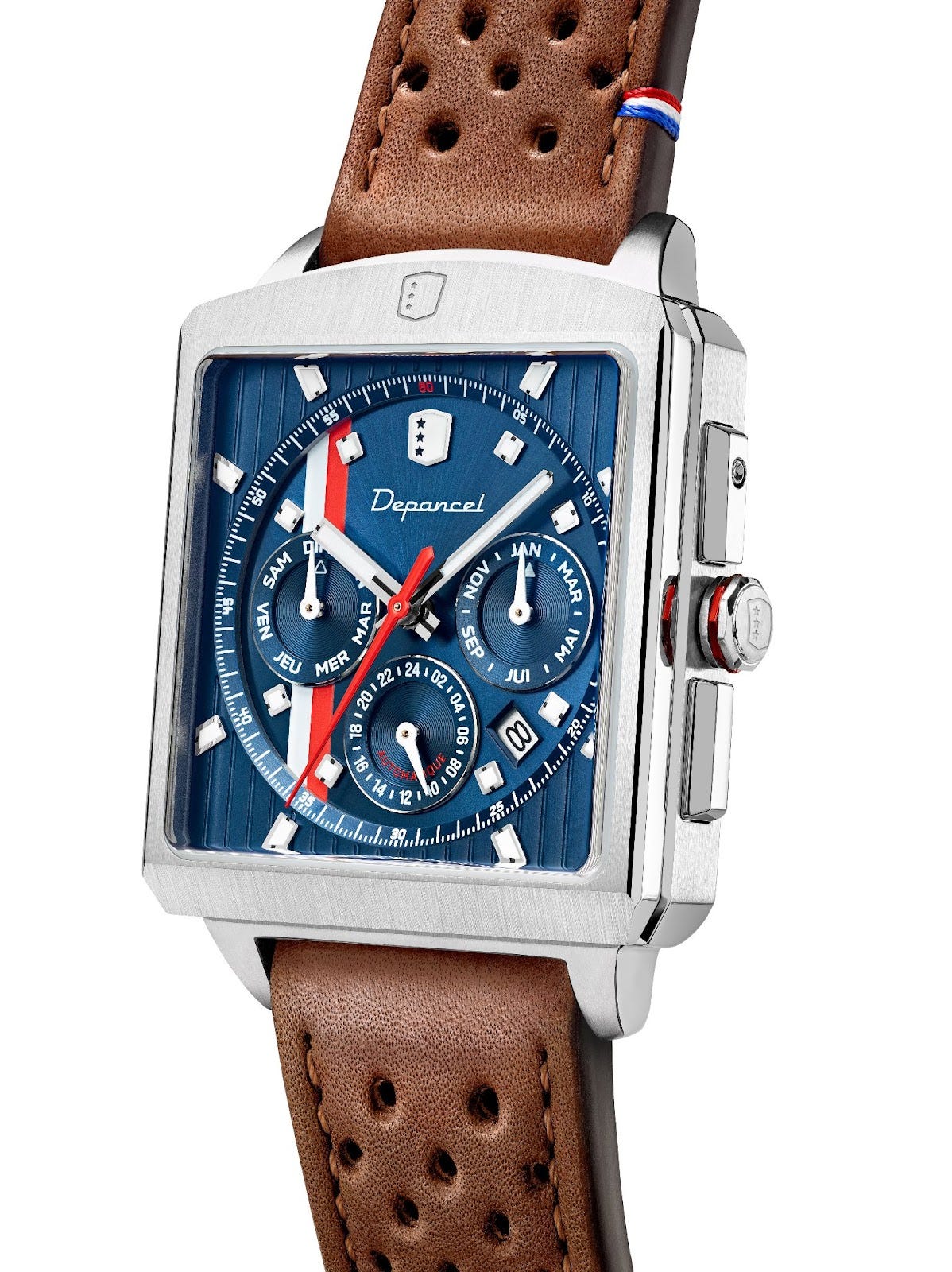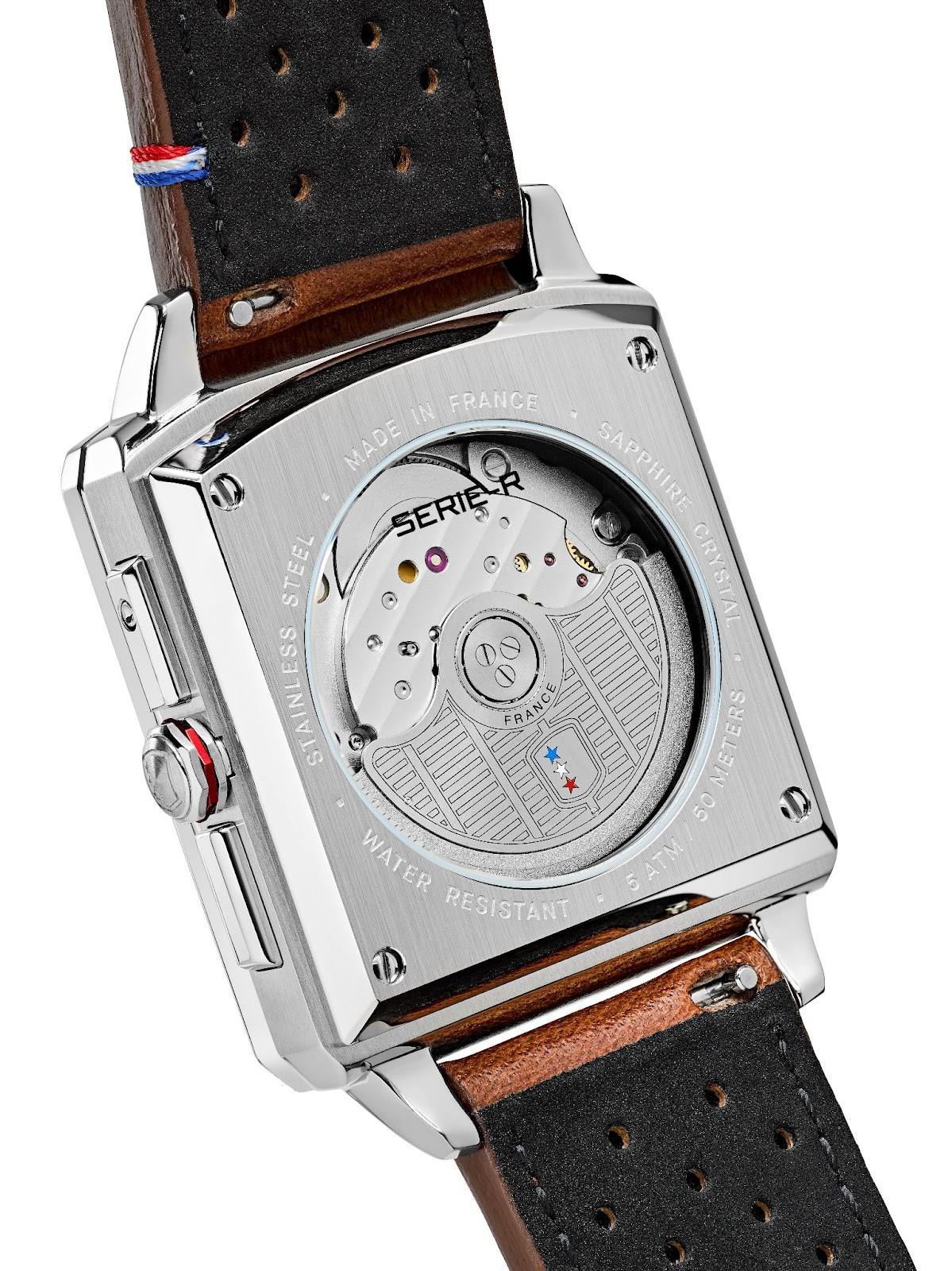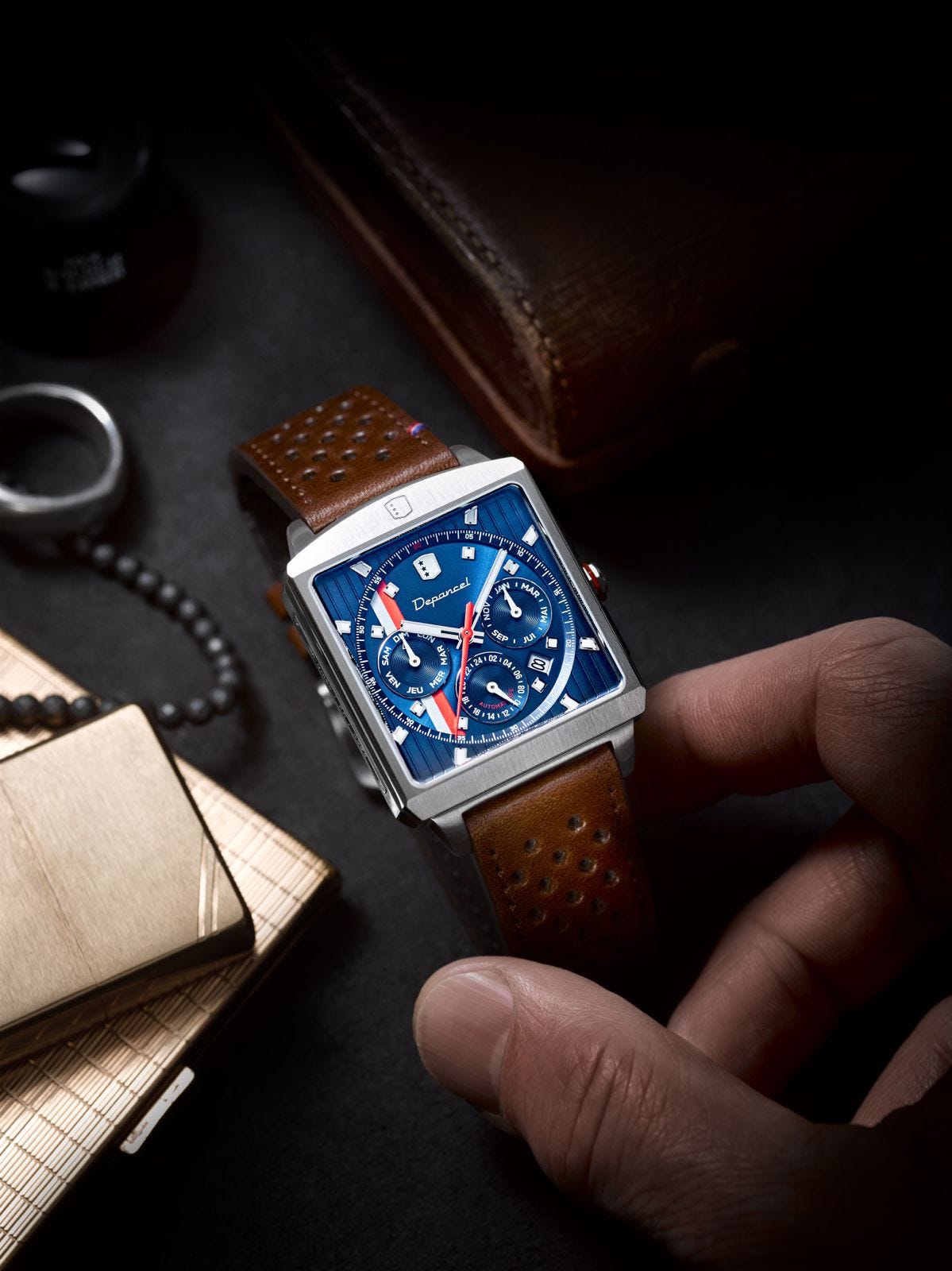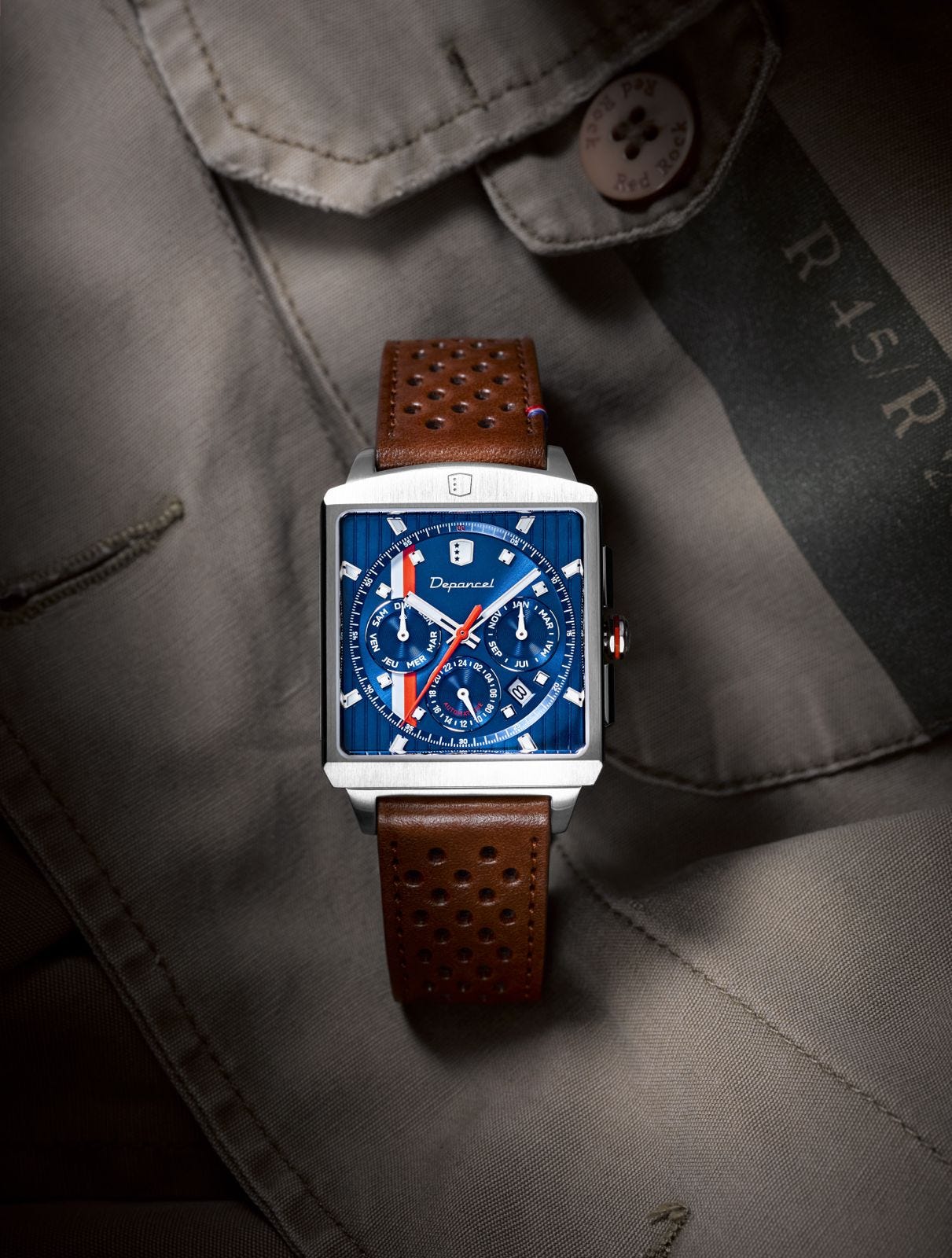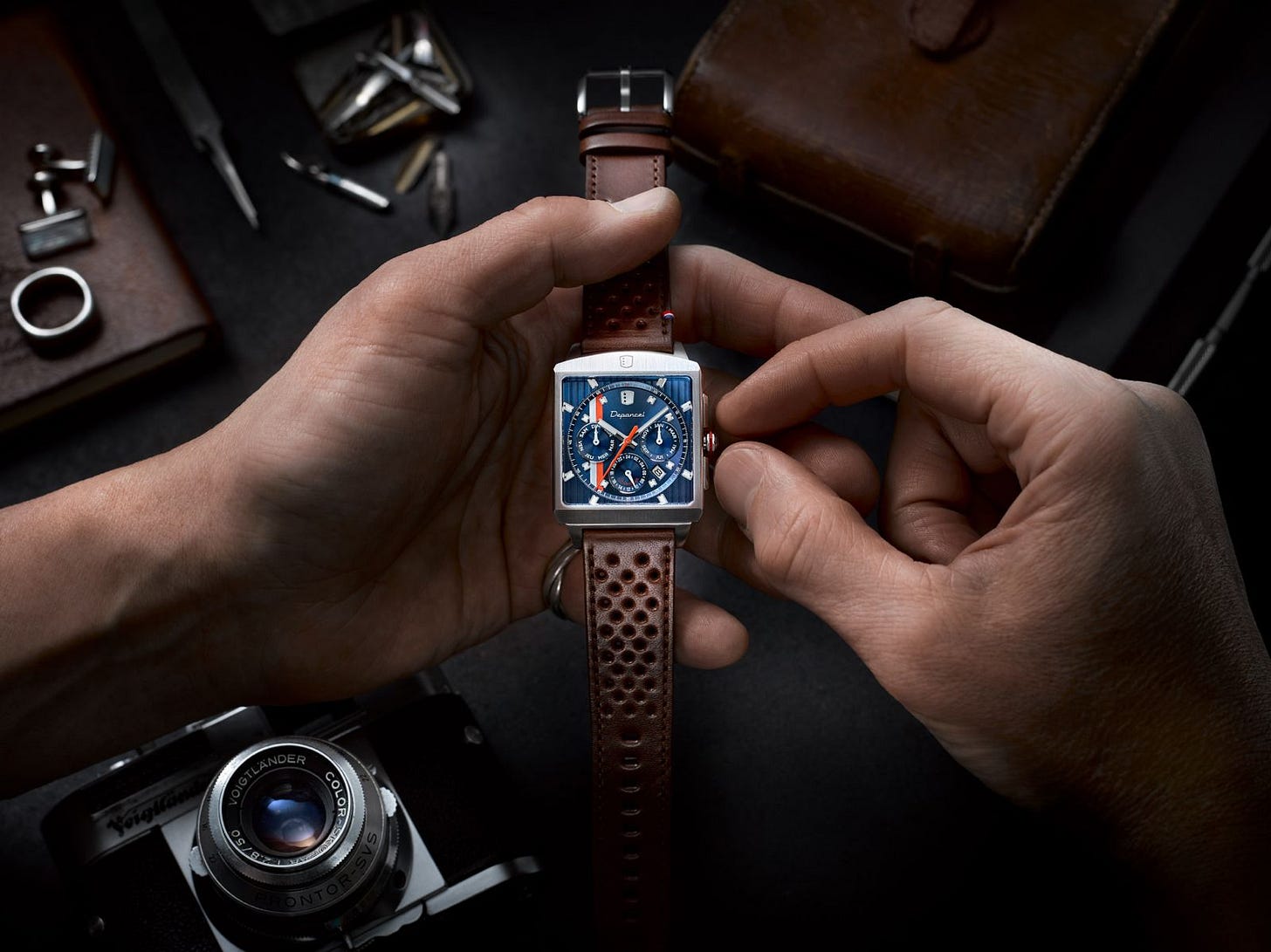The Geometry of Nostalgia
In 1937, the Delage D8 120S Aero Coupe emerged with its distinctive squared radiator grille—a geometric anomaly defiant against the curved trends of its era. Today, Depancel summons this ghost in steel and sapphire.
The SÉRIE-R R01 CALENDRIER AUTOMATIQUE arrived February 2025, bearing the angular silhouette of its automotive ancestor. In the crowded field of automotive-inspired timepieces, one wonders: can a watch truly capture the spirit of mechanical monsters that once thundered across French roads?
Unveiling the Square Challenger
This timepiece maintains Depancel's signature square case—a deliberate rejection of horological orthodoxy. At 36mm wide by 43mm long, it commands attention without overwhelming modesty.
The blue PVD dial features two-tier construction with vertical racing stripes in French tricolor. Three subdials display day, date, and 24-hour function, arranged in a configuration that sacrifices some legibility for symmetry. "Dashboard" hands cut across with high-contrast coloration.
Beneath ticks a Japanese Miyota 9120 automatic movement—a choice revealing much about Depancel's market positioning. Running at 28,800 vibrations per hour with a 40-hour power reserve, it features custom decoration visible through the display caseback.
Why a Square Case in a Round World?
The square watch exists as deliberate provocation—a rejection of the natural circle that time suggests. Depancel aligns with rebels like TAG Heuer's Monaco and Cartier's Santos. This choice transcends aesthetics.
A square case positions the wearer as someone valuing distinction over convention. Water resistance becomes harder to achieve; movement fitting requires greater precision; proportional balance demands careful consideration.
Beyond technical challenges lies a deeper statement: time itself is not always circular. Our experience can be angular, with sharp corners and unexpected edges. The square acknowledges this human experience—structured, compartmentalized, sometimes jarring.
For Depancel, the square also serves as visual shorthand, an instantly recognizable silhouette drawing direct lineage from the Delage D8—a connection that resonates with automotive enthusiasts they court.
Japanese Movements in French Cases
No choice reveals more about Depancel's philosophy than selecting the Miyota 9120. Japanese calibers in French watches represent modern pragmatism that might have shocked the nationalistic industrialists whose automotive legacies they invoke.
This decision places Depancel at an interesting crossroads. By choosing reliability and accessibility over Swiss exclusivity, they acknowledge contemporary watchmaking economics while claiming heritage from an era when national industrial pride was paramount.
The choice reveals Depancel's true positioning: democratic luxury prioritizing wearability and affordability over horological pedigree. It creates tension with their narrative of French craftsmanship, yet reflects a realistic balancing act between aspiration and accessibility.
This Japanese heart beating inside a French case becomes a metaphor for globalized production pursuing optimal performance-to-price ratio—perhaps appropriately automotive in spirit.
Depancel's Branding Strategy: Heritage Without History
The name "Depancel"—a portmanteau of Delage, Panhard, and Facel Vega—reveals their approach to heritage. By fusing three historic French marques, they create synthetic lineage, borrowing gravitas rather than earning it through decades of operation.
Their strategy targets a specific demographic: primarily male, European, with sufficient disposable income for discretionary purchases but not unlimited resources. They appeal to those who appreciate mechanical objects, feel nostalgic for European industrial prominence they likely never experienced firsthand, and seek differentiation without ostentatious luxury.
The tricolor accents, perforated straps, and automotive inspirations speak to a specific masculinity associated with mid-century motorsport—a romantic ideal of the gentleman driver. By pricing at €850, Depancel makes this identity accessible to professionals who cannot afford five-figure timepieces.
This strategy—democratic access to exclusivity-signaling design—offers emotional benefits of luxury ownership without extreme financial sacrifice.
Evolution or Revolution?
The CALENDRIER AUTOMATIQUE represents evolution rather than revolution. The core design language remains intact, with refinements rather than reinventions. The calendar complication adds functionality without disrupting established aesthetic, suggesting a brand prioritizing consistency over novelty.
This incremental approach reveals Depancel's development philosophy. Rather than chasing trends or releasing radically different models annually, they commit to gradual refinement of core identity. The "facelift" mentioned in their press materials acknowledges this measured pace.
For collectors, this approach offers reassurance that today's purchase won't be rendered obsolete by tomorrow's release. For the brand, it allows consolidation of identity and manufacturing processes.
However, this evolutionary path carries risks in a marketplace driven by novelty and social media visibility. Without dramatic new releases to generate buzz, Depancel relies on their core design's strength and word-of-mouth from existing customers.
The Monaco Question: Inspiration vs. Imitation
The undeniable visual similarity between the SÉRIE-R and TAG Heuer's iconic Monaco raises questions about the line between inspiration and imitation—a blurry boundary in watchmaking where design language often transcends brand boundaries.
This resemblance affects perception differently depending on the viewer. For casual observers, the SÉRIE-R might register as an affordable Monaco alternative. For horological purists, the similarity might diminish Depancel's perceived originality. For pragmatists, the price difference makes the comparison academic.
Depancel must navigate this visual similarity carefully—acknowledging influences without seeming derivative, establishing unique identity while working within recognizable design language. Their emphasis on specific French automotive connections rather than broader racing heritage represents one differentiation strategy.
Their challenge lies not in avoiding resemblance to established designs—impossible in a mature industry—but in bringing sufficient originality and value to justify their market position.
Brand Blueprint: The Depancel Identity
Depancel's core identity revolves around four elements: French automotive heritage, accessible luxury pricing, distinctive square designs, and motorsport aesthetics.
By focusing on automotive connection rather than watchmaking history, they sidestep the challenge faced by market newcomers—lack of heritage. Instead, they borrow credibility from automotive legends, creating alternative lineage appealing to car enthusiasts.
Their pricing strategy positions them in a growth segment as established luxury brands move upmarket. The €850 price point represents significant investment for casual consumers while remaining accessible to enthusiasts.
The square case serves both aesthetic and marketing functions—creating immediate visual recognition while challenging the ubiquitous round paradigm.
Finally, the motorsport aesthetics—perforated straps, dashboard-inspired hands, tricolor accents—appeal to a specific masculine identity associated with driving and technical appreciation.
Closing Thoughts: Square Pegs in Round Holes
The Depancel SÉRIE-R R01 CALENDRIER AUTOMATIQUE exists as compelling contradiction—a modern watch wrapped in nostalgic aesthetics, a French brand with Japanese engineering, a luxury object at non-luxury pricing.
In an increasingly homogenized market where established brands play it safe, Depancel's square offering represents refreshing willingness to challenge conventions. Their pricing acknowledges economic realities facing many enthusiasts, while their design ambitions reach beyond their price bracket.
Like the square case that defines it, this watch refuses to be a round peg in a round hole. It exists proudly as alternative—not pretending to be something it isn't, but offering value through distinctive design, reliable engineering, and accessible pricing. In doing so, it squares a difficult circle: creating desire without exclusionary pricing.
If you enjoyed this article, consider subscribing to receive more insights on independent watchmaking and horological culture.
About the Author
Sergio Galanti is a journalist specializing in independent watchmaking and mechanical horology.



